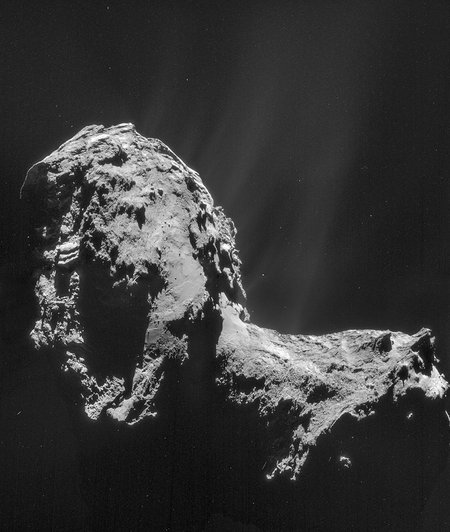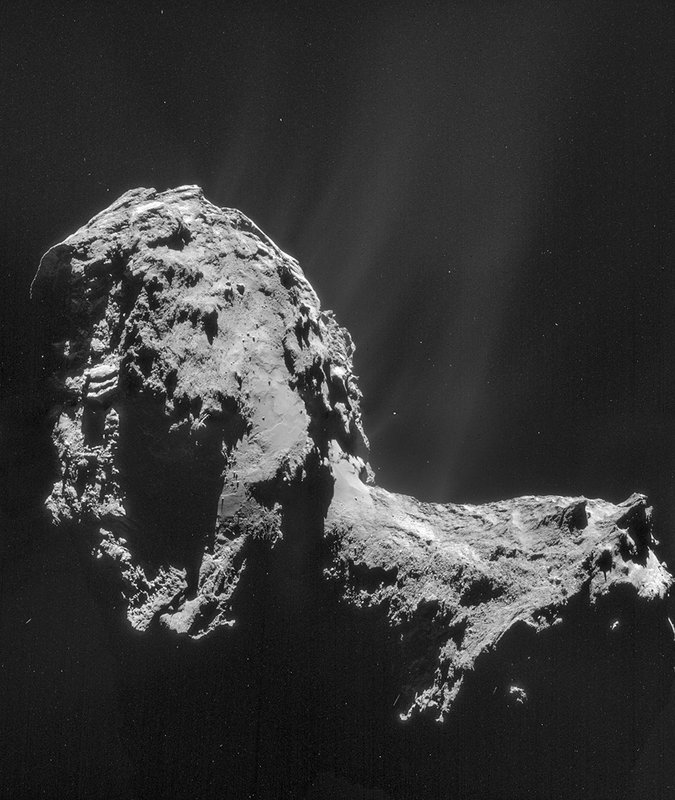Rosetta, named for the inscribed stone that allowed 19th-century historians to unlock the secrets of ancient Egypt, is unlocking the secrets of a far more ancient comet. Rosetta team member Paul Weissman will divulge some of them on Wednesday, October 14, at 8 p.m. in Caltech's Beckman Auditorium. Admission is free.
Q; What do you do?
A: I'm a planetary astronomer; I study bodies in the solar system. My particular specialty is comets, and right now I'm very fortunate to be part of the European Space Agency's Rosetta mission to comet 67P/Churyumov-Gerasimenko. As one of the mission's interdisciplinary scientists, I advise the individual instrument teams and the project as a whole.
Past cometary missions have been fast flybys that spent less than a day near the comet. Rosetta is a two-year rendezvous; it matched orbits with the comet a year ago, and is flying with it on its eccentric path around the sun. Rosetta has watched the comet go from a dormant state out near Jupiter's orbit to a high state of activity as it came almost as close to the sun as Earth's orbit. This year, Rosetta will monitor the comet's decrease in activity on its outbound journey.
The mission is actually two spacecraft: an orbiter and a lander. The orbiter is circling the comet's nucleus, which is the solid core of volatile ices—mostly water—as well as silicates and organics. Rosetta has been imaging the nucleus, determining its composition, measuring its mass and density, and studying its interaction with the solar wind.
Philae, Rosetta's lander, was released on November 12, 2014, and provided detailed images and other measurements from the surface of the nucleus. However, Philae unexpectedly bounced on landing and wound up leaning against an outcrop, preventing some key measurements from being made.
Q: Why are comets important?
A: As frozen, unmodified leftovers from the formation of the solar system 4.56 billion years ago, comets provide a detailed record of the composition and physical conditions in the solar nebula—the interstellar cloud of dust and gas from which the solar system formed. Comet nuclei, like asteroids, give us clues as to how tiny dust and ice grains came together to form larger bodies—first the comets and asteroids, and later the moons and planets. Missions to take samples from a comet and return them to Earth are on the drawing boards. But right now Rosetta is providing us with a wealth of information for understanding the earliest stages of solar-system formation.
Studying comets may also shed light on the origin of life on Earth. For life to begin, Earth needed a broad combination of organic molecules and elements that we like to call the "primordial soup." We know that the early Earth was bombarded by comets and asteroids that contained those ingredients, so it may be that we are only here because of those impacts.
Q: How did you get into this line of work?
A: Sputnik 1, Earth's first artificial satellite, was launched a few days after my 10th birthday. I was fascinated by the space program and its discoveries, which led to an interest in astronomy. Fortunately, I had teachers who encouraged this interest. My sixth-grade teacher had a telescope and showed us sunspots one afternoon. I was hooked.
When I was in grad school at UCLA, my thesis adviser, George Wetherill, suggested that I look into the orbital dynamics of the Oort cloud. Frankly, I had to ask him what it was. He told me that in 1950, a Dutch astronomer named Jan Oort had suggested that comets came from a vast spherical cloud of comets surrounding the planetary system and so distant that a nudge from a passing star could send a comet plunging toward the sun. My thesis was a computer simulation of this process, including gravitational perturbations from Jupiter and Saturn as they either steered the comets into periodic orbits or ejected them to interstellar space.
The model also included physical loss mechanisms, such as collisions with the planets, random disruption (comets sometimes fall apart for no obvious reason), and loss of all of their volatile ices, which makes them more difficult to find. My simulations proved that Oort's theory was right, and I was off and running.
At about the same time, I got tired of being a starving student. A part-time job opportunity arose at JPL and I jumped at it, joining a group that designed trajectories for future spacecraft missions. When I finished my PhD, I was invited to go full time as a science coordinator on NASA's Galileo mission to Jupiter, and 41 years later, here I am.
Named for the late Caltech professor Earnest C. Watson, who founded the series in 1922, the Watson Lectures present Caltech and JPL researchers describing their work to the public. Many past Watson Lectures are available online at Caltech's iTunes U site.
 This composite is a mosaic of four Rosetta NAVCAM images taken at a distance of 19 miles from the center of comet 67P/Churyumov-Gerasimenko.
Credit: ESA/Rosetta/NAVCAM
Back to the Beginning: The Rosetta Comet Rendezvous Mission - P. Weissman - 10/14/2015
This composite is a mosaic of four Rosetta NAVCAM images taken at a distance of 19 miles from the center of comet 67P/Churyumov-Gerasimenko.
Credit: ESA/Rosetta/NAVCAM
Back to the Beginning: The Rosetta Comet Rendezvous Mission - P. Weissman - 10/14/2015

